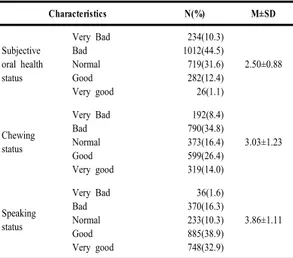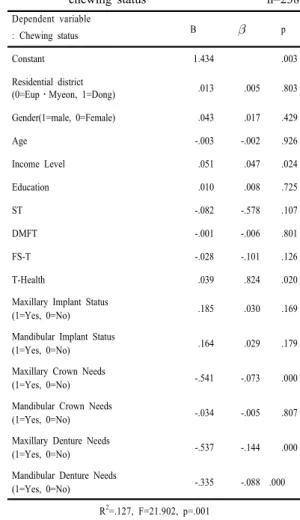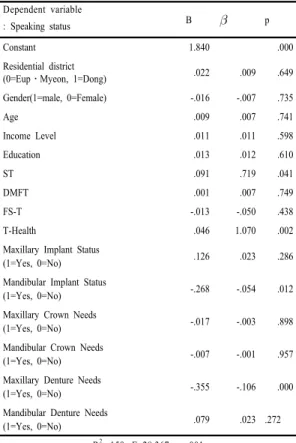Vol. 17, No. 1 pp. 72-78, 2016
*Corresponding Author : Han-Gon Kim (Yeungnam Universiry) Tel: +82-53-810-2255 email: hgkim@yu.ac.kr
Received October 5, 2015 Accepted January 5, 2016
Revised (1st November 26, 2015, 2nd December 28, 2015, 3rd January 4, 2016) Published January 31, 2016
한국 노인의 구강보건지수와 치과보철물 필요도가 구강건강관련 삶의 질에 미치는 영향
이희성1, 김한곤2*
1영남대학교 환경보건대학원 보건학과, 2영남대학교 사회학과
The Effect of Oral Health Index and Dental Prosthesis Needs on Oral Health Related Quality of Life in Korean Elderly
Hee-Sung Lee
1, Han-Gon Kim
2*1Department of Health Graduate School of Environment & Public Health, Yeungnam University
2Department of Sociology, Yeungnam University
요 약 이 연구는 한국 노인의 구강건강상태와 치과보철물 필요도가 구강건강관련 삶의 질에 미치는 요인을 경험적으로 규명함으로써 향후 노인대상의 구강건강사업에 필요한 기초자료를 제공하고자 한다. 이 연구자료는 2010년 1월부터 12월까 지 질병관리본부에서 시행한 '국민건강영양조사 제5기 1차 및 2차년도를 활용 구강검사까지 완료한 65세 이상 노인 2,389명 중 검사가 미흡한 노인 116명을 제외한 2,273명을 최종 연구대상으로 하였다. 수집된 자료는 SPSS 22.0 프로그램을 이용하여 전산통계 처리하였으며, 분석방법은 빈도분석, 다중회귀분석, 구조방정식 모형을 이용하였다. 주관적 구강건강상태에 영향을 미치는 요인은 나이가 적을수록, ST지수가 높을수록, FS-T 지수가 높을수록, T-Health 지수가 높을수록, 상악 크라운 요구도 가 낮을수록, 상·하악 의치 요구도가 낮을수록 주관적 구강건강상태가 높은 것으로 나타났다. 씹기문제에 영향을 미치는 요인 은 소득수준이 높을수록, T-Health 지수가 높을수록, 상악 크라운 요구도가 낮을수록, 상·하악 의치 요구도가 낮을수록 씹기 문제가 불편하지 않는 것으로 나타났다. 말하기 문제에 영향을 미치는 요인은 ST지수가 높을수록, T-Health 지수가 높을수록, 상악 임플란트 요구도가 낮을수록, 상악 의치 요구도가 낮을수록 말하기 문제가 불편하지 않는 것으로 나타났다. 이상의 결과를 토대로 구강건강상태와 치과보철물 필요도는 구강건강관련 삶의 질에 상당한 영향을 미치고 있음을 알 수 있었고, 향후 노인의 구강건강 관련 삶을 증진시키기 위해서는 노인을 위한 구강건강증진사업과 치과보철 사업이 필요가 요구된다.
Abstract This study examined the oral health-related quality of life of the elderly using the oral health index and dental prosthesis status, and explored methods to improve the oral health status.
The data collected from 'The fifth Korean national health and nutrition examination survey 2010' were analyzed.
The subjects were 2273 elderly people, aged 65 years or older, who had completed an oral examination, health questionnaires and nutrition examination. Statistical analysis was done using the SPSS 22.0 for Windows. Frequency analysis, multiple regression analysis and structural equation model were used for statistical analysis.
The general characteristics, oral health index and dental prosthesis showed differences in the subjective oral health status associated with as age, ST, FS-T, T-Health, maxillary crown needs, maxillary denture needs, mandibular denture needs, chewing status associated with the income level, FS-T, maxillary crown needs, maxillary denture needs, mandibular denture needs, speaking status associated with the ST, T-Health, maxillary implant status, and maxillary denture needs.
In conclusion, both the oral health index and dental prosthesis needs affect the oral health related quality of life of the elderly. Governments should implement a variety of oral health programs and dental prosthesis policies to improve the quality of life related oral health of the elderly.
Keywords : Oral health index, Dental prosthesis status, Oral health related quality of life
1. 서론
한국은 지난 반세기동안 의료기술의 발달과 생활수준 의 향상으로 건강수준이 높아지고 평균수명이 괄목하게 성장되었다. 가파른 우리나라의 인구고령화는 단기간의 그속한 출산율 감소에 따른 유소년인구의 감소와 평균수 명 연장에 따른 노인인구 증가에 기인되지만, 선진국의 인구고령화는 출산율 감소에 따른 유소년인구의 감소와 평균수명 증가에 따른 노인인구 증가가 순차적으로 진행 되고 있다[1].
현재 우리나라는 고령화 사회에 진입됨에 따라 노인 에 대한 많은 문제점이 발생하고 있으며 관심 또한 높아 지고 있다. 인구고령화는 경제활동인구의 비율감소, 노 인부양 부담 증가, 경제활동인구 자체를 고령화 시키는 등 다양한 문제점을 가지고 있지만, 그 중에서도 건강과 관련된 문제는 노인에게 삶을 유지하는 데 있어서 무엇 보다 중요하다.
건강 문제에서도 구강건강은 소화 및 영양 섭취와 깊 은 관련성을 가지고 있어, 전신건강과 함께 노년기에 가 장 문제가 되고 있는 사항이다[2]. 또한 구강건강과 전신 건강은 노인의 안녕에 중요한 요소로[3], 전신건강 수준 이 나쁜 사람은 치아보존 가능성이 줄어들어 저작능력이 낮아지게 됨으로 구강건강과 전신건강은 밀접한 관계를 가지고 있다[4]. 이처럼 구강건강과 전신건강은 밀접하 게 관련이 있기 때문에 기본적인 일상생활의 수행에서 기능적 일상생활까지에 있어서 중요한 요소이다. 노인의 구강건강문제는 치아상실, 구강통증과 같은 구강 내 문 제뿐만 아니라 호흡기계 감염, 심혈관계 질환, 뇌졸중, 당뇨, 영양불량 등과 같은 전신건강뿐만 아니라 삶의 질 과도 직결되어 있다[5].
노년기에 치아의 상실은 저작능력이 저하, 기능제한, 의치에 의한 통증과 같은 문제로 식사의 양과 질이 떨어 져 일상생활의 무기력으로 건강유지가 어려워질 수 있다 [6]. 또한 치아의 결손은 발음과 외모에 영향 주기 때문 에 사회생활과 대인관계에 제한을 주어 고립감과 사회적 소외감을 촉진시켜 장애를 유발하므로 치아 상실은 개인 의 삶의 질에 영향을 미치게 되었다[7].
건강이 삶의 질에 직접적인 영향을 미치는 인자로서 인식되어 건강관련 삶의 질에 대한 연구가 광범위하게 이루어지고 있는 것과[8, 9] 아울러, 구강건강과 관련한 삶의 질에 대한 관심도 높아져 구강건강관련 삶의 질에
대한 독립적인 모형개발의 필요성이 제기되었다[10].
구강건강관련 삶의 질은 1978년 Giddon에 의해 처음 으로 구강건강 상태와 관련된 삶의 질의 개념이 정립되 어, Atchison and Dolan[11]이 개발한 노인구강건강평가 지수(Geriatric Oral Health Assessment Index: GOHAI) 는 노인의 구강건강관련 삶의 질을 평가하는 도구로 이 용 되었고, Slade and Spencer[12]가 개발한 구강건강영 향조사(Oral Health Impact Profile : OHIP)는 Locker의 구강건강에 관한 이론적 모델을 기초로 하여 국내에서 많은 연구가 진행되어 왔지만, 대규모의 광범위 국가조 사 데이터를 바탕으로 다양한 영향요인을 추출하여 구조 방정식 모형을 적용한 연구는 미비한 수준이다.
따라서 이 연구는 한국 노인의 구강보건지수와 치과 보철물 필요도 등 다각적인 요인을 파악하여, 구강건강 관련 삶의 질에 미치는 영향을 조사함으로써, 향후 노인 들의 구강건강상태와 이에 영향을 미치는 관련요인을 파 악하고, 노인의 구강건강을 증진시킬 수 있는 구강보건 정책의 방향을 도출하고자 한다.
2. 연구방법
2.1 연구자료 및 대상
이 연구는 만1세 이상 가구원 전체를 조사대상으로 하여 면접방법 및 자기기입방식으로 이루어진 제 5기 1 차년도, 2차년도 국민건강영양조사의 조사결과를 기초 자료로 이용하였다. 연구기간은 5기 1차년도는 2010년 1월부터 12월까지 조사가 이루어졌으며, 5기 2차년도는 2011년 1월부터 12월까지 조사가 이루어졌다. 가중치의 적용 비율은 제5기 국민건강영양조사 원시자료 이용지 침서에 따라 적용하였다. 1차년도 국민건강영양조사에 직접 응답한 조사자수는 총 3,840가구 이었고, 이 중 이 연구에서는 사용된 변수들의 정보가 누락되지 않은 65 세 이상의 노인 1,073명, 2차년도 국민건강영양조사에 직접 응답한 조사자수는 총 3,840가구 이었고, 이 중 이 연구에서는 사용된 변수들의 정보가 누락되지 않은 65 세 이상의 노인 1316명을 포함하여 2389명을 최종 연구 대상으로 하였다.
2.2 주요변수
2.1.1 종속변수 : 구강건강관련 삶의 질
구강건강 관련 삶의 질 변수는 주관적 구강건강상태, 씹기문제, 말하기 문제 등을 사용하였다. 주관적 구강건 강상태는 본인이 인지하는 구강건상상태로서 1점 매우 나쁨에서 5점 매우 좋음 까지의 5점 척도로 측정되었고, 씹기문제는 음식을 씹는데 불편감을 느끼는 정도로 1점 불편함에서 5점 전혀 불편하지 않음까지의 5점 척도로 측정되었고, 말하기 불편은 명확한 발음을 하는데 어려 움이나 불편감을 느낀 정도로 1점 매우 불편함에서 5점 전혀 불편하지 않음 까지의 5점 척도로 측정되었다.
Table 1. Oral health related quality of life of study subject
Characteristics N(%) M±SD
Subjective oral health status
Very Bad Bad Normal Good Very good
234(10.3) 1012(44.5) 719(31.6) 282(12.4) 26(1.1)
2.50±0.88
Chewing status
Very Bad Bad Normal Good Very good
192(8.4) 790(34.8) 373(16.4) 599(26.4) 319(14.0)
3.03±1.23
Speaking status
Very Bad Bad Normal Good Very good
36(1.6) 370(16.3) 233(10.3) 885(38.9) 748(32.9)
3.86±1.11
2.1.2 독립변수 : 인구사회적특성, 치과보철물 필 요도, 구강보건지수
국민건강영양조사는 자기기입식, 면접방법, 직접계 측․관찰․검체분석 등의 방법을 통해 구축된 자료이므 로 개인의 주관적인 응답과 과학적인 자료로 구성되어 있다. 이 연구에서는 구강건강 관련 삶의 질에 영향을 주 는 개연성이 있는 개인변수와 구강보건지수, 치과보철물 필요도를 추출하였다. 연구에 이용된 개인변수로는 성 별. 연령, 거주지, 교육정도, 경제상태로 개인의 일반적 특성을 나타낼 수 있는 변수들이다. 구강보건지수에 관 한 변수는 ST, DMFT, FS-T, T-Health 등을 사용하였다.
ST는 건전치아 수를 계산하였고, DMFT 지수는 우식영 구치, 우식경험처치영구치, 우식경험상실영구치를 합산 하여 산출하였고, FS-T 지수는 건전영구치, 우식경험처 치영구치, 전색영구치, 우식비경험처치영구치를 합산하 여 산출하였고, T-Health 지수는 건전영구치는 4점, 전
색영구치, 우식경험처치영구치, 우식비경험처치영구치 는 2점, 우식영구치는 1점, 상실치아는 0점을 부과하여 합산하여 산출하였다. 치과보철물 필요도에 관한 변수는 상·하악 임플란트, 상·하악 가공의치 필요도, 상·하악 의 치필요도 등을 사용하였다. 상·하악 임플란트 상태는 없 음, 1개 이상으로 구분하였고, 상·하악 가공의치 필요도 는 없음, 1개 이상으로 구분하였고, 상·하악 의치필요도 는 없음, 의치 필요로 분류하여 사용하였다.
Table 2. General characteristics and dental prosthesis needs
Characteristics N(%) Characteristics N(%)
Gender Residential district
Male 1012(44.5) Dong 1552(68.3)
Female 1261(55.5) Eup․Myeon 721(31.7)
Income Level Education
Low 587(25.8) Elementary 1499(65.9)
Lower Middle 567(24.9) Middle 285(12.5)
Upper Middle 566(24.9) High 338(14.9)
High 553(24.3) College 151(6.6)
Age
65-69 993(43.7)
70-74 618(27.2)
75≤ 662(29.1)
Maxillary Implant Needs Mandibular Implant Needs
No 2178(95.8) No 2157(94.9)
Yes 95(4.2) Yes 116(5.1)
Maxillary Crown Needs Mandibular Crown Needs
No 2208(97.1) No 2196(96.6)
Yes 65(2.9) Yes 77(3.4)
Maxillary Denture Needs Mandibular Denture Needs
No 1992(87.6) No 2003(88.1)
Yes 281(12.4) Yes 270(11.9)
2.3 통계분석
이 연구에서 수집된 자료는 Statistical Package for Social Sciences 22.0 for windows(Chicago, IL, USA)를 이용하여 처리하였으며, 자료 분석을 위해 사용한 통계 분석 방법은 다음과 같다.
조사대상자의 인구사회적 특성, 구강보건지수, 치과 보철물 필요도가 구강건강관련 삶의 질에 어떤 영향력이 있는지를 알아보기 위해 다중회귀분석(Multiple Regression Analysis)과 구조방정식(Structural equation model) 모형을 실시하였다.
3. 연구결과
3.1 인구사회학적 특성, 구강보건지수, 치과보 철물 필요도와 주관적 구강건강상태와의 관계
나이가 적을수록(=-.129), ST지수가 높을수록(
=1.401), FS-T 지수가 높을수록(=.297), T-Health 지 수가 높을수록(=1.657), 상악 크라운 요구도가 낮을수 록(=-.068), 상·하악 의치 요구도가 낮을수록 주관적 구 강건강상태가 높은 것으로 나타났다(=-.115)(Table 3).
Table 3. The effects of general characteristics, oral health index and dental prosthesis needs on subjective oral health status n=2389 Dependent variable
: Subjective oral health status B p
Constant .487 .159
Residential district
(0=Eup․Myeon, 1=Dong) -.013 -.007 .730
Gender(1=male, 0=Female) .036 .020 .361
Age -.135 -.129 .000
Income Level .001 .002 .933
Education -.008 -.009 .712
ST .142 1.401 .000
DMFT -.001 -.006 .805
FS-T .060 .297 .000
T-Health .057 1.657 .000
Maxillary Implant Status
(1=Yes, 0=No) -.119 -.027 .217
Mandibular Implant Status
(1=Yes, 0=No) .028 .007 .753
Maxillary Crown Needs
(1=Yes, 0=No) -.361 -.068 .001
Mandibular Crown Needs
(1=Yes, 0=No) .025 .005 .804
Maxillary Denture Needs
(1=Yes, 0=No) -.307 -.115 .000
Mandibular Denture Needs
(1=Yes, 0=No) -.208 -.077 .000
R2=.117, F=19.947, p=.001
ST: sound teeth, DMFT: decayed, missing and filled teeth, FS-T:
functioning teeth
3.2 인구사회학적 특성, 구강보건지수, 치과보 철물 필요도와 씹기문제와의 관계
소득수준이 높을수록(=.047), T-Health 지수가 높을 수록(=.824), 상악 크라운 요구도가 낮을수록(
=-.073), 상·하악 의치 요구도가 낮을수록 씹기 문제가 불편하지 않는 것으로 나타났다(=-.144)(Table 4).
Table 4. The effects of general characteristics, oral health index and dental prosthesis needs on chewing status n=2389 Dependent variable
: Chewing status B p
Constant 1.434 .003
Residential district
(0=Eup․Myeon, 1=Dong) .013 .005 .803
Gender(1=male, 0=Female) .043 .017 .429
Age -.003 -.002 .926
Income Level .051 .047 .024
Education .010 .008 .725
ST -.082 -.578 .107
DMFT -.001 -.006 .801
FS-T -.028 -.101 .126
T-Health .039 .824 .020
Maxillary Implant Status
(1=Yes, 0=No) .185 .030 .169
Mandibular Implant Status
(1=Yes, 0=No) .164 .029 .179
Maxillary Crown Needs
(1=Yes, 0=No) -.541 -.073 .000
Mandibular Crown Needs
(1=Yes, 0=No) -.034 -.005 .807
Maxillary Denture Needs
(1=Yes, 0=No) -.537 -.144 .000
Mandibular Denture Needs
(1=Yes, 0=No) -.335 -.088 .000
R2=.127, F=21.902, p=.001
3.3 인구사회학적 특성, 구강보건지수, 치과보 철물 필요도와 말하기 문제와의 관계 ST지수가 높을수록(=0.719), T-Health 지수가 높을 수록(=1.070), 상악 임플란트 요구도가 낮을수록(
=-.054), 상악 의치 요구도가 낮을수록 말하기 문제가 불 편하지 않는 것으로 나타났고(=-.106)(Table 5).
Table 5. The effects of general characteristics, oral health index and dental prosthesis needs on speaking status n=2389 Dependent variable
: Speaking status B p
Constant 1.840 .000
Residential district
(0=Eup․Myeon, 1=Dong) .022 .009 .649
Gender(1=male, 0=Female) -.016 -.007 .735
Age .009 .007 .741
Income Level .011 .011 .598
Education .013 .012 .610
ST .091 .719 .041
DMFT .001 .007 .749
FS-T -.013 -.050 .438
T-Health .046 1.070 .002
Maxillary Implant Status
(1=Yes, 0=No) .126 .023 .286
Mandibular Implant Status
(1=Yes, 0=No) -.268 -.054 .012
Maxillary Crown Needs
(1=Yes, 0=No) -.017 -.003 .898
Mandibular Crown Needs
(1=Yes, 0=No) -.007 -.001 .957
Maxillary Denture Needs
(1=Yes, 0=No) -.355 -.106 .000
Mandibular Denture Needs
(1=Yes, 0=No) .079 .023 .272
R2=.159, F=28.367, p=.001
3.4 인구사회학적 특성, 구강보건지수, 치과보 철물 필요도와 구강건강관련 삶의 질 구강건강관련 삶의 질에 영향을 미치는 요인은 보철 물 상태 및 필요도, 구강보건지수로 나타났다. 즉, 보철 물 상태 및 필요도가 적을수록, 구강보건지수가 높을수 록 구강건강관련 삶의 질에 긍정적인 것으로 나타났다 (Table 6).
Table 6. The effects of general characteristics, oral health index and dental prosthesis needs on oral health related quality of life n=2389
Variable C.R p
oral health related quality of life
<-- dental prosthesis needs -.576 -2.291 .022
<-- oral health index .253 8.107 .001
<-- Oral health behavior -.026 -0.678 .498
Fig. 1. Structural equation modeling
4. 고찰 및 결론
건강개념의 변화로 인해 구강건강관리에 대한 필요성 이 크게 인식되고 있으며, 노년기에서 구강건강은 삶의 질에 영향을 미치기 때문에, 행복하고 건강한 삶의 질을 영위하기 위해서 노인의 구강건강의 중요성은 증대하고 있다[13]. 구강보건이 건강에 필수적이지만 노인들은 치 아의 문제를 정상적인 노화 현상으로 인식하여 불편하다 는 것을 알리려고 하지 않기 때문에 치과를 잘 찾지 않 고, 구강질환은 조기발견 및 치료가 매우 중요함에도 현 재 시행되고 있는 구강보건정책은 국민의 적극적인 호응 을 얻지 못하고 있다[14]. 이에 이 연구는 국민건강영양 조사 1기, 2기 원시자료를 이용하여, 한국 노인의 구강 보철물 상태 및 필요도가 구강건강관련 삶의 질에 미치 는 영향을 파악하고자 수행하였다. 이 연구결과를 고찰 해보면 다음과 같다.
인구·사회적 특성에서는 연령이 낮을수록 주관적 구 강건강상태가 높게 나타났는데, 고 연령 집단이 저 연령 집단보다 구강건강관련 삶의 질이 부정적인 것으로 나타 난 김숙경[15], 이동호[16] 연구결과와 일치하고 있어 연 령이 증가할수록 구강건강관련 삶의 질을 저하시키는 요 인임을 확인할 수 있었다. 경제상태가 높을수록 구강건 강관련 삶의 질이 높게 나타났는데, 이는 허익강 등[17]
과 이가령[18]의 연구와 일치된 결과로, 노인에게 있어 서 교육수준은 과거의 사회경제적위치의 변화까지를 보 다 잘 반영할 수 있었기 때문에 교육수준에서 보다 뚜렷 한 차이를 보였다.
상하악 보철물 필요도에서는 상·하악 의치 필요도가 적을수록 구강건강관련 삶의 질이 높게 나타났다.
McGrath and Bed[19]는 가철성 및 고정성 치과보철물 이 없는 치아 상실은 구강건강과 관련된 삶의 질을 평가 하는 중요한 도구이며, 삶의 질을 측정하는데 상당한 영 향을 준다고 하였고, Heydecke 등[20]은 의치를 착용하 는 것은 구강건강관련 삶의 질에 부정적인 영향을 준다 고 하였다.
이 연구는 2차 자료인 국민건강영양조사 자료를 활용 하여 분석하였기 때문에 표본의 대표성은 높지만, 방법 론에서 다음과 같은 제한점이 있다. 단면적 자료를 통하 여 연구를 진행하였으므로 변수간의 관련성은 파악할 수 있었지만 인과관계를 규명하는데 한계가 있으므로 이 연 구에서 도입된 변수들을 포함한 종단면 연구를 통해 변 수들 상호간의 연관성을 보다 구체적으로 검증하고 추적 조사할 필요가 있다.
이상의 결과로부터 우리나라 노인에서 구강건강관련 삶의 질과 인구·사회적 특성, 치과보철물 상태 및 필요 도, 구강보건지수 변수들과의 직접적인 관련성을 확인하 였다. 노인의 구강건강 관련 삶의 질을 증진시키기 위해 서는 다각적인 요인들을 고려하여야 하며, 노인층에서 빈발하는 구강질환을 중심으로 국가차원의 구강건강증 진사업의 체계적인 수립과 수행이 절실히 필요하며, 노 인의 구강건강을 관리 할 수 있는 다양한 정책 및 프로 그램의 활성화가 요구된다[21].
References
[1] Korea Institute for Health and Social Affairs,
"Restructure of public welfare delivery system in response to demographic changes", pp. 3-15, 2012.
[2] Y. S. Won. "The relationship of oral state and dietary habit to health condition among elderly people", master's thesis, Yonsei University, Seoul, 2003.
[3] D. Locker, M. Clarke, B. Payne, "Self-reported oral health status, psychological well-being and life satisfaction in an older adult population", J Dental Res, Vol.79, pp. 970-975, 2000.
DOI: http://dx.doi.org/10.1177/00220345000790041301 [4] D. Locker, D Matear, "Status and changes in masticatory
ability in older Canadians over seven year". J Public Health Dent, Vol.62, No.2, pp. 70-77, 2002.
DOI: http://dx.doi.org/10.1111/j.1752-7325.2002.tb03425.x [5] U.S. Department of Health and Human Services. Oral
health in America: A report of the surgeon general. pp.
25-30, 2010.
[6] J. H. Park, H. K. Kwon, B. I. Kim, C. H. Choi, Y. H.
Choi, "A survey on the oral health condition of institutionalized elderly people resident in free a asylum", Journal of Korean Academy of Oral Health, Vol.26, No.4, pp. 555-566, 2002.
[7] D. Locker, "Measuring oral health: a conceptual framework". Community Dental health, Vol.5, pp. 5-13, 1998.
[8] Y. M. Kim, H. R. Choi, D. Y. Park, J. B. Im, J.W. Won, B. S. Kim, Y. U. Park, "The comparision of the quality of life between the well-controlled hypertension group and the uncontrolled hypertension group". Korean Academy of Family Medicine, Vol.22, No.4, pp.
565-574, 2001.
[9] B. K, Ahn, S. J. Lee, G. G. Nam Y. L. Jeong, S. H. Lee,
"The Korean Version of Skindex-29". Korean journal of dermatology Vol. 42, No.1, pp. 9-15, 2004.
[10] DS. Brennan, AJ. Spencer, "Comparison of a generic and a specific measure of oral health related qualiyoif life", Community Dent Health, Vol.22, pp. 11-18, 2005.
[11] KA. Atchison, TA. Dolan, "Development of the Geriatric Oral Health Assessment Index", J Dent Educ, Vol.54, No.11, pp. 680-687, 1990.
[12] GD. Slade, AJ Spencer, "Development and evaluation of the oral health impact profile", Community Dent Health, Vol.11, pp. 3-11, 1994.
[13] S. R. Woo, "The effect of the health state of the oral cavity and the health-caring act on the oral cavity on the life quality concerning the health of the oral cavity of the senior", doctor's thesis, Daegu Haany University, Daegu, 2013.
[14] J. H. Park, "Relationship between tooth loss and oral health related quality of life among the elderly population in Seongju", master's thesis, Kyungpook National University, Daegu, 2008.
[15] S. K. Kim, "A study for Raising the Quality of the Rural Old Aged Men`s Lives", Korean sociey of Gerontological social welfare, Vol. 23, pp. 179-202, 2004.
[16] D. H. Lee, "The Effects of Quality of Life in the Elderly`s Health Condition", The korean Gerontological society, Vol.30, No.1, pp. 93-108, 2010.
[17] I. G. Hur, T. Y. Lee, J. K. Dong, S. H. Hong. "The effects of dental prostheses to the quality of life among the elderly", The Journal of Korean Academy of Prosthodontics, Vol.48, No.2, pp. 101-110, 2010.
DOI: http://dx.doi.org/10.4047/jkap.2010.48.2.101 [18] G. R. Lee, "The impact of DMFT index on oral health
related quality of Life in community-dwelling elderly", Journal of Korean Academy of Oral Health, Vol.32, No.3, pp. 396-404, 2008.
[19] C. McGrath, R. Bed, "Can dentures improve the quality of life of those who have experienced considerable tooth loss", J Dent, Vol.29, pp. 243-256, 2001.
DOI: http://dx.doi.org/10.1016/S0300-5712(00)00063-4 [20] G. Heydecke, LA. Tedesco, C. Kowalski, MR. Inglehart,
"Complete dentures and oral health-related quality of life-do coping styles matter", Community Dent Oral Epidemiol, Vol.32, pp. 297-306, 2004.
DOI: http://dx.doi.org/10.1111/j.1600-0528.2004.00169.x
[21] M. H. Park, M. Y. Park, H. S. Lee, "The Effect of Sociological Characteristics and Oral Health Behaviors on Oral Health Index in Korean Elderly", Journal of the Korea Academia-Industrial cooperation Society, Vol.14, No.10 pp. 4989-4995, 2013.
DOI: http://dx.doi.org/10.5762/KAIS.2013.14.10.4989
이 희 성(Hee-Sung Lee) [준회원]
•2014년 2월 : 영남대학교 대학원 보건학과 (보건학석사)
<관심분야>
구강보건학, 치과보철
김 한 곤(Han-Gon Kim) [정회원]
•1985년 12월 : The University of Texas at Austin, Sociology (사회 학박사)
•2014년 1월 ~ 현재 : 한국인구학회 회장
•1986년 3월 ~ 현재 : 영남대학교 사회학과 교수
<관심분야>
사회학, 인구학


